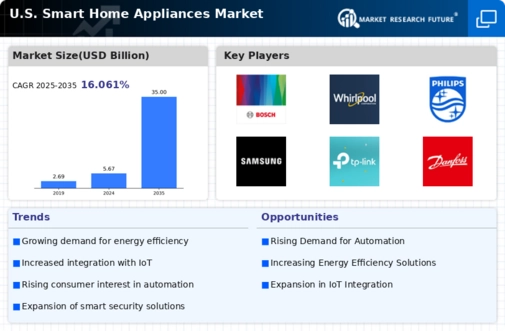Rising Awareness of Home Security
Rising awareness of home security concerns significantly influences the smart home-appliances market. Consumers are increasingly prioritizing safety and security features in their purchasing decisions. The demand for smart security systems, including cameras and alarms, has surged, with sales projected to grow by 30% in the coming year. This heightened focus on security is not only about protecting physical assets but also about ensuring the safety of family members. As a result, manufacturers are integrating advanced security features into their appliances, such as remote monitoring and alerts. This trend indicates a shift in consumer priorities, where the smart home-appliances market is adapting to meet the growing need for enhanced security solutions.
Technological Advancements in IoT
Technological advancements in the Internet of Things (IoT) play a pivotal role in shaping the smart home-appliances market. The integration of IoT technology enables appliances to communicate with each other and with users, enhancing functionality and user experience. In 2025, it is estimated that over 50% of households in the US will have at least one smart appliance, reflecting a significant shift towards connected living. This trend is driven by the increasing availability of affordable smart devices and the growing consumer awareness of their benefits. As IoT technology continues to evolve, it is expected to introduce new capabilities, such as predictive maintenance and energy management, further driving growth in the smart home-appliances market.
Growing Consumer Demand for Convenience
The smart home-appliances market experiences a notable surge in consumer demand for convenience solutions. As lifestyles become increasingly hectic, consumers seek appliances that simplify daily tasks. This trend is reflected in the rising sales of smart kitchen devices, which have seen an increase of approximately 25% in the last year alone. The desire for seamless integration and automation in household chores drives innovation in the smart home-appliances market. Consumers are particularly drawn to products that offer remote control capabilities, allowing them to manage their home environment from anywhere. This growing preference for convenience is likely to propel the market further, as manufacturers respond with advanced features that cater to the evolving needs of consumers.
Sustainability and Eco-Friendly Products
Sustainability and eco-friendly products are becoming increasingly important in the smart home-appliances market. Consumers are more conscious of their environmental impact and are seeking appliances that promote energy efficiency and reduce waste. In 2025, it is estimated that eco-friendly appliances will account for over 40% of the market share, reflecting a significant shift towards sustainable living. Manufacturers are responding to this demand by developing products that utilize renewable materials and energy-efficient technologies. This trend not only appeals to environmentally conscious consumers but also aligns with regulatory initiatives aimed at reducing carbon footprints. As sustainability becomes a core value for many consumers, the smart home-appliances market is likely to see continued growth in this segment.
Increased Integration with Home Automation Systems
Increased integration with home automation systems is a driving force in the smart home-appliances market. As consumers invest in comprehensive home automation solutions, the demand for compatible smart appliances rises. This trend is evidenced by the growing number of devices that can be controlled through centralized platforms, such as smartphones or voice assistants. In 2025, it is projected that nearly 60% of smart appliances will be compatible with major home automation systems, facilitating seamless user experiences. This integration not only enhances convenience but also allows for more efficient energy management and improved functionality. As the market evolves, manufacturers are likely to focus on creating products that offer enhanced compatibility with existing home automation technologies.






















Leave a Comment